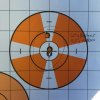Vulture
Member
I am very new to reloading, and have a broad question. When reaching the max end of a load, is it possible for ES to start to go down? Here's an example load:
Remington Brass
Federal 215
93 grains H1000
215grain Berger
I have no pressure signs, shooting out of a 26" factory savage 110, performance is:
3115 avg Fps
20 SD
59 ES
Should I work up to the true max load, or is it likely that ES will increase? I know there are no shortcuts, but I'm somewhat limited on components and time right now, and wonder if it would be more efficient in the short term (until after this fall hunting season) to start working back down to a lower ES?
Secondary question, i am using a cheap hornady gs-1500 digital, has always checked out against my rcbs 505. Would I be better served to do all loads with the 505? Thanks!
Remington Brass
Federal 215
93 grains H1000
215grain Berger
I have no pressure signs, shooting out of a 26" factory savage 110, performance is:
3115 avg Fps
20 SD
59 ES
Should I work up to the true max load, or is it likely that ES will increase? I know there are no shortcuts, but I'm somewhat limited on components and time right now, and wonder if it would be more efficient in the short term (until after this fall hunting season) to start working back down to a lower ES?
Secondary question, i am using a cheap hornady gs-1500 digital, has always checked out against my rcbs 505. Would I be better served to do all loads with the 505? Thanks!

